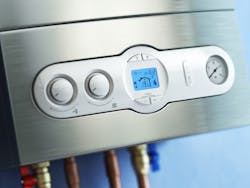Reduce your energy consumption for heating domestic hot water by 50 percent
There are actually a lot of ways to reduce energy consumption related to the production of domestic hot water. Setting of a reasonably sized solar preheat system is one excellent way. You will spend between $10,000 and $20,000 to achieve that goal. Granted, there is a decent tax credit to help defer the initial installation costs, but with energy being as cheap as it currently is, the return on the investment is still rather long, with no guarantees of reaching pay back before the system needs replaced. And even though I am a big fan of using renewable energy, the economics of a solar thermal domestic hot water heating system are not a place that I’d consider putting my money to find a good return on the investments. Most people that install solar thermal systems are doing so as a measure to conserve energy for future generations to use, not to see a good return on the investment.
I’ve always taught that conservation at the point of use should be exhausted before a person considers using any sort of alternative energy measures. Having an older shower head that flows at an excessive rate of around 5 GPMs, and replacing it with a 2-1/2 gallon flow rate shower head not only cuts energy consumption by 50 percent, but also reduces the consumption of potable, treated water, as well as lessening the load on sewage treatment by the same amount for that particular use. What a lot of people fail to take into consideration is the cost of water and sewage treatment and the cost to transport water. These expenses are huge and add up quickly, but are rarely taken into consideration for water conservation efforts. The numbers vary by state, but in 2012, a study determined that the energy used for pumping and treating potable water ran between 12 percent and 19 percent of our total energy usage. So even though the consumers don’t actually “see” the bill for the energy consumed in its transportation and treatment, they are still paying for it through their water and sewer bills.
In my 40 years of working in the energy conservation field, the one device, if you will, that has really impressed me is drain waste heat recovery systems. One in particular that I have personal experience with is a double walled, copper drain waste heat exchanger called the GreenFoX, which can be seen at swing-green.com. This simple device, which runs between $1,000 and $2,000 installed, depending upon the distance between the vertical drain stack of a building and the hot water heating system, will recover up to 50 percent of the energy that would normally exit the home by way of the building sewer. This energy is sent back into the incoming cold water, preheating it before it enters the domestic hot water heating system, regardless of the type of water heater in place. It can show a return on the investment in as little as two years, and as long as five years, depending on the number of people in the home, energy being used for heating the hot water (electric versus gas), and the cost of the energy used for heating of hot water.
For the life of me, I don’t understand why something this simple isn’t a requirement.
Even under the worst case scenario of five years, it is an excellent return on the investment. Unlike a solar thermal system, this system requires no service because it has no moving parts, other than the waste stream running inside and the potable water running on the outside of the heat exchanger.
When applied to large commercial dishwashing systems, in a restaurant for example, its thermal efficiency gets even higher due to the higher exiting water temperatures associated with the typical commercial dishwasher. Some of these dishwashing machines discharge at 180°F. By code, this is too hot to be discharged directly into a sanitary sewage system. That would normally require cold water dilution to get the discharge below the acceptable limit of around 140°F. This results in additional water waste that is unnecessary. With the drain waste heat exchanger connected to the dishwashers discharge, preheating the domestic hot water results in a discharge temperature that is well within acceptable limits.
Lower water discharge temperatures also allow the building grease trap to work more efficiently, which can result in additional dollar savings where the waste water treatment district enforces rules regarding greasy waste discharge surcharges.
For the life of me, I don’t understand why something this simple isn’t a requirement. The Canadians have made it mandatory in the Quebec province. They realize the value of drain waste heat recovery. In my professional opinion, we too should be making its use mandatory.
Tune in next month when we will look at some very simple refrigerant waste heat recovery systems that also make excellent economic sense. Until then, Happy Green Hydronic Solution Hydronicing!
Mark Eatherton material on this website is protected by Copyright 2017. Any reuse of this material (print or electronic) must first have the expressed written permission of Mark Eatherton and CONTRACTOR Magazine. Please contact via email at: [email protected].
About the Author
Mark Eatherton
Mark Eatherton material on this website is protected by Copyright 2017. Any reuse of this material (print or electronic) must first have the expressed written permission of Mark Eatherton and CONTRACTOR Magazine.
